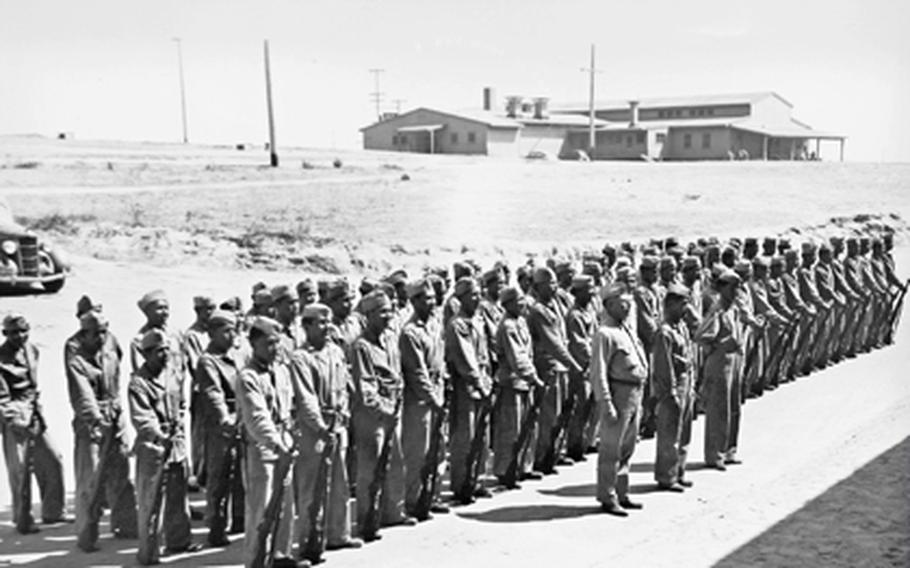
A platoon of Navajo Code Talkers stand in formation at Camp Elliot, Calif., under the supervision of Staff Sgt. Philip Johnston. The Navajo created the first version of the their code at Camp Elliot. (Courtesy Photo)
(Tribune News Service) — Supporters of a plan to build a museum to honor the Navajo Code Talkers are still about $40 million from making the project a reality.
Though the state put $6.4 million in capital outlay funds toward the project this year, the museum's organizers face a significant financial climb before doors could open, the CEO of the Navajo Code Talkers Museum said last week.
"Our capacity is severely limited," Regan Hawthorne told members of the interim Indian Affairs Committee. "We're still fledgling, we're still gaining momentum in finding our identity."
The Code Talkers were U.S. Marines who conveyed military orders, maneuvers and plans in their own language, bewildering the Japanese during World War II and helping American forces gain ground and victories in the Pacific.
Hawthorne is the son of the late Roy Hawthorne, a Navajo Marine veteran who served as a Code Talker on various South Pacific islands from 1942 to 1945.
The project, budgeted at more than $46 million, has been in the works since 2019, when the late John Pinto, a code talker and Democratic state senator from Gallup, first managed to acquire more than $1.2 million from funding controlled by fellow lawmakers and Gov. Michelle Lujan Grisham.
Pinto, who served as a Code Talker, had unsuccessfully worked for years to get the funding for the museum. In 2009, Chevron Mining Co. donated more than 200 acres in McKinley County for the project. The site, close to the Arizona border, is in the area most of the Code Talkers called home.
But the museum initiative has not gained much momentum since then for a number of reasons, Hawthorne told lawmakers.
Among other challenges, the museum's leaders have to finalize a deal with the Navajo Nation regarding the land for the museum. Hawthorne said to avoid a problem with the state's anti-donation clause, museum leaders are working on a deal to gift or sell the land to the Navajo Nation. He said he hopes that plan is finalized within a few months.
Meanwhile, finding funding has been challenging, in part because of the confusion over the land and the fact the museum's organizers do not have an administrative office where they can meet people and solicit financial support, Hawthorne told the committee members.
"We're not yet capable of operating a museum," he said during the hearing.
Several lawmakers, including Rep. Eliseo Alcon, D- Milan, and Rep. Anthony Allison, D-Fruitland,suggested Hawthorne seek federal funding since the Code Talkers served for the U.S. military.
"This project should not be handled locally. The Navajo language is what saved America during World War II," Allison said, adding it should be the federal government "we hold responsible for the building of this museum."
He noted there are only three Navajo Code Talkers still living.
Hawthorne and Sen. Shannon Pinto, D- Gallup — granddaughter of John Pinto — said the problem with that plan is it would cede oversight of the museum to the federal government, and not the state or the Navajo Nation.
"If the feds did it, it would not be the Navajo Code Talker Museum, it would be about all national code talkers," she said in an interview after the hearing.
Hawthorne told committee members he thinks the Navajo Nation would put some money into the project, though he could not say how much. He said in the interview he hopes leaders there would at least match the roughly $7.5 million New Mexico has invested in the project.
He said the money raised will serve as a "leveraging point" for the board to go to corporations and foundations for additional support.
To date, the museum board has raised about $50,000 in donations, he said.
The work of the Navajo Code Talkers has been heralded because the Japanese military proved adept at breaking American codes on troop movements in the South Pacific before the Navajos' arrival.
The Navajos' Diné language was unwritten, and few non-Navajos knew it. Strategists created a code of more than 200 Diné words conveyed by Navajos serving in the Marines. Not only did the code baffle the Japanese, but also the Allied forces and even Navajos who did not know the code.
"The enemy never understood what we were saying," John Pinto said years ago during one legislative hearing on the initiative.
(c)2023 The Santa Fe New Mexican (Santa Fe, N.M.)
Visit at www.santafenewmexican.com
Distributed by Tribune Content Agency, LLC.